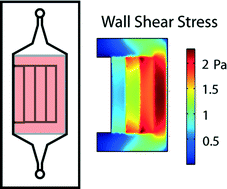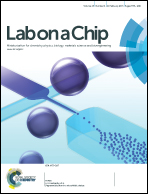Application of multiple levels of fluid shear stress to endothelial cells plated on polyacrylamide gels†
Abstract
Measurements of endothelial cell response to fluid shear stress have previously been performed on unphysiologically rigid substrates. We describe the design and implementation of a microfluidic device that applies discrete levels of shear stress to cells plated on hydrogel-based substrates of physiologically-relevant stiffness. The setup allows for measurements of cell morphology and inflammatory response to the combined stimuli, and identifies mechanisms by which vascular stiffening leads to pathological responses to blood flow. We found that the magnitude of shear stress required to affect endothelial cell morphology and inflammatory response depended on substrate stiffness. Endothelial cells on 100 Pa substrates demonstrate a greater increase in cell area and cortical stiffness and decrease in NF-κB nuclear translocation in response to TNF-α treatment compared to controls than cells plated on 10 kPa substrates. The response of endothelial cells on soft substrates to shear stress depends on the presence of hyaluronan (HA). These results emphasize the importance of substrate stiffness on endothelial function, and elucidate a means by which vascular stiffening in aging and disease can impact the endothelium.


 Please wait while we load your content...
Please wait while we load your content...